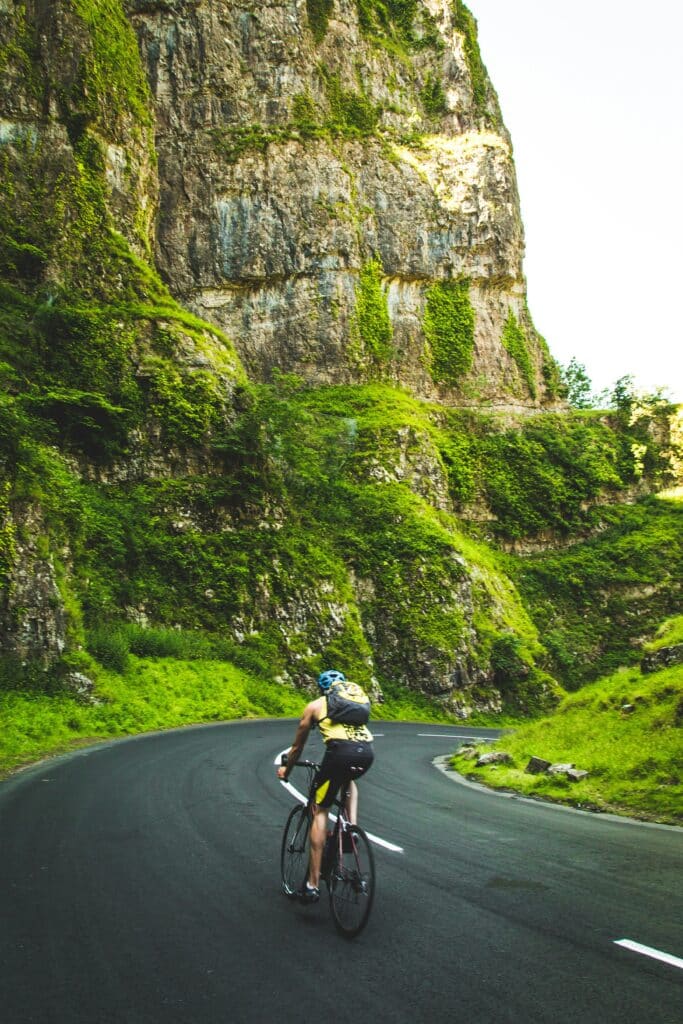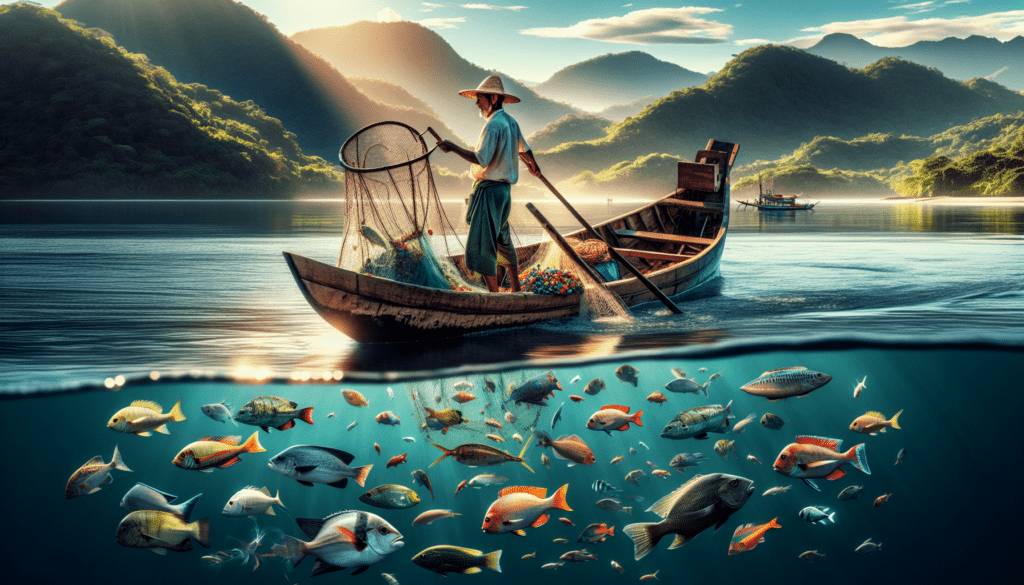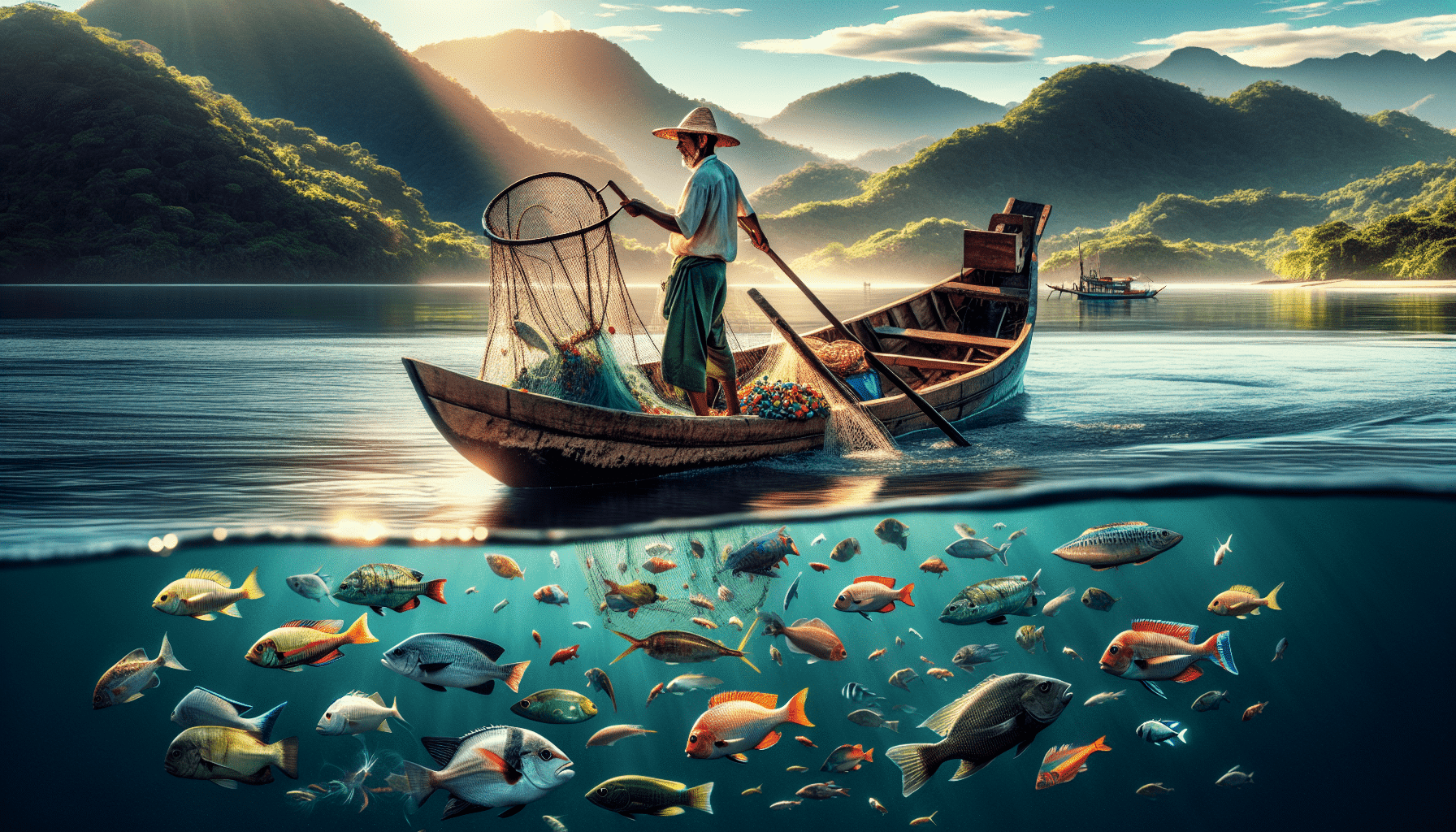If you’re an avid angler or simply looking to try your hand at fishing in a tropical paradise, look no further than Guanacaste, Costa Rica. With its abundance of pristine coastlines and diverse marine life, this region offers a fishing experience like no other. Join us as we share our firsthand knowledge and expertise, accumulated over five years of living in this beautiful area. In this ultimate guide to Guanacaste fishing, we’ll provide you with all the information you need to make the most of your fishing adventure, from the best spots to target various species, to the local regulations and recommended equipment. So grab your rod and get ready to reel in the big ones – Guanacaste awaits!

Guanacaste: Overview and Background
Guanacaste, located in the northwestern part of Costa Rica, is a province known for its stunning beaches, vibrant culture, and, of course, excellent fishing opportunities. Situated between the Pacific Ocean to the west and the Guanacaste Mountain Range to the east, this region boasts a diverse geographical landscape that contributes to its rich marine life. The history of fishing in Guanacaste dates back centuries, with a deep-rooted connection to the local communities. Additionally, the climate in Guanacaste plays a significant role in the abundance of fish species found in its waters.
Geographical location of Guanacaste
Guanacaste’s geographical location is one of its biggest assets for fishing enthusiasts. The province is bordered by the Pacific Ocean to the west, offering easy access to both nearshore and offshore fishing grounds. To the east, the Guanacaste Mountain Range provides a stunning backdrop and helps create diverse ecosystems that support a wide range of fish species. From the pristine beaches to the tropical forests, Guanacaste’s geography sets the stage for unforgettable fishing experiences.
History of fishing in Guanacaste
Fishing has been a way of life in Guanacaste for generations. The local communities have traditionally relied on fishing as a means of sustenance and as an integral part of their culture. Historically, fishing in Guanacaste was primarily done by local fishermen using traditional techniques such as hand lines and nets. However, with the rise of tourism, recreational fishing has become increasingly popular in the region. This has led to the growth of fishing charters and tour companies that cater to both local and international anglers, helping to preserve the region’s fishing heritage while promoting responsible practices.
Climate and its effect on fishing
The climate in Guanacaste heavily influences the fishing conditions throughout the year. The province experiences a tropical climate with two distinct seasons – the dry season and the rainy season. The dry season, which runs from December to April, is characterized by clear skies, calmer seas, and warmer water temperatures. This period offers excellent fishing opportunities, especially for offshore species like marlin, sailfish, and dorado. On the other hand, the rainy season, spanning from May to November, brings occasional showers and slightly cooler water temperatures. Despite the rain, fishing during this season can still be rewarding, as the region sees an increase in inshore species like roosterfish, snappers, and jacks.
Best Season for Fishing in Guanacaste
Overview of fishing seasons
Guanacaste’s fishing seasons can be broadly categorized into the dry season and the rainy season, each offering unique opportunities to catch different species. The dry season, known for its calm waters and warm temperatures, is considered the prime time for offshore fishing. During this season, pelagic species such as marlin, sailfish, and tuna are more abundant and actively feeding. The rainy season, though marked by occasional showers, offers excellent inshore fishing. Roosterfish, snappers, and jacks are just a few examples of the species that thrive along Guanacaste’s shores during this time.
Species to catch in each season
In the dry season, offshore fishing enthusiasts flock to Guanacaste in hopes of landing trophy-sized billfish. Pacific sailfish are particularly prevalent during this time, with the region being considered one of the best places in the world for sailfish angling. Marlin, both blue and striped, are also commonly found offshore. Other species that can be targeted in the dry season include dorado, yellowfin tuna, and wahoo.
During the rainy season, inshore fishing takes center stage. Roosterfish, known for their aggressive strikes and impressive fighting capabilities, are a prized catch. Snappers, jacks, and grouper are also abundant in the coastal areas, providing anglers with exciting opportunities to test their skills and reel in delicious catches. Additionally, during this time, freshwater fishing in rivers and lakes becomes a popular alternative, offering a tranquil and serene fishing experience.
Weather conditions and their effect on fishing
When planning a fishing trip to Guanacaste, considering the weather conditions is essential. The dry season, with its clear skies and calm waters, provides optimal conditions for offshore fishing. The warmer water temperatures attract pelagic species closer to the surface, creating ideal opportunities for anglers. However, it’s important to keep an eye on occasional wind patterns, especially in the afternoons, as they can impact the sea conditions.
In contrast, the rainy season brings occasional rain showers and slightly cooler water temperatures. While this may deter some anglers, the somewhat challenging conditions can be offset by the abundance of inshore species. Local knowledge and guidance from experienced fishing guides can help navigate these conditions and ensure a successful fishing trip, regardless of the season.

Fishing Equipment Needed
Basic fishing gear necessities
Before embarking on any fishing adventure in Guanacaste, it’s important to have the necessary fishing gear. Whether you’re a seasoned angler or a beginner, certain basic equipment is essential. A good-quality fishing rod and reel suited to the type of fishing you plan to do is a fundamental requirement. Additionally, a selection of hooks, sinkers, and fishing line of appropriate strength should be included in your tackle box. Other essential items include pliers, a fishing knife, a first aid kit, and a cooler to store your catch.
Specialized equipment for Guanacaste
While the basic fishing gear is sufficient for many fishing trips in Guanacaste, there are a few specialized equipment pieces that can enhance your experience. If you’re targeting large pelagic species like marlin or sailfish, a reliable fighting chair and harness are highly recommended. These provide stability and support during the fight, ensuring that you can reel in your trophy catch without straining yourself.
If you’re planning to do inshore fishing, investing in a sturdy pair of wading boots can be beneficial. These boots provide traction and protect your feet when wading through the rocky shores and shallow waters. Additionally, a good pair of polarized sunglasses can help reduce glare on the water’s surface, allowing you to spot fish more easily.
Recommended brands and places to purchase
When it comes to fishing gear, quality is crucial to ensure a successful and enjoyable fishing experience. There are several reputable brands that offer reliable fishing equipment suited to Guanacaste’s fishing conditions. Some popular fishing tackle brands include Shimano, Penn, Daiwa, and Okuma, known for their durability and performance.
For those visiting Guanacaste, there are several local fishing tackle shops and outdoor stores where you can purchase or rent fishing gear. Tamarindo, Playas del Coco, and Playa Flamingo are some of the popular coastal towns that have well-stocked tackle shops. Additionally, many fishing charter operators provide all the necessary equipment for their clients, saving you the hassle of purchasing and transporting gear.
Hiring a Guide vs. Going Alone
Benefits of hiring a guide
For many anglers visiting Guanacaste, deciding whether to hire a fishing guide or venture out on their own can be a challenging decision. Hiring a fishing guide comes with several benefits that can greatly enhance your fishing experience. Firstly, local guides possess extensive knowledge of the region, including the best fishing spots, current conditions, and species behavior. Their expertise can significantly increase your chances of having a successful day on the water.
Moreover, fishing guides are equipped with top-of-the-line gear and boats specifically designed for fishing in Guanacaste. This saves you the worries of bringing your own equipment and ensures that you have access to the right tools for the job. Additionally, guides provide invaluable assistance with bait selection, techniques, and even offer coaching for beginners, allowing you to learn new skills and improve your fishing technique.
Advantages of independent fishing
While hiring a fishing guide has its advantages, some anglers prefer the freedom and flexibility that comes with independent fishing. Going alone allows you to have complete control over your fishing itinerary and explore at your own pace. It also allows you to fully immerse yourself in the experience, enjoying the solitude and solitude of the water.
Independent fishing can also be a more economic option, especially for experienced anglers who already possess their own fishing gear. If you have prior knowledge of the area, fishing techniques, and species behavior, you may feel confident in navigating Guanacaste’s waters on your own. However, it’s important to note that local knowledge, weather conditions, and regulations should always be taken into consideration to ensure a safe and successful fishing trip.
How to choose a fishing guide
If you decide that hiring a fishing guide is the right choice for you, selecting the perfect guide can make all the difference in your fishing experience. When choosing a fishing guide in Guanacaste, consider the following factors:
-
Experience and knowledge: Look for guides who have a deep understanding of the local waters, fishing techniques, and the behavior of different fish species. Ask for recommendations or read online reviews to gauge their expertise.
-
Reputation and testimonials: Research the guide’s reputation within the fishing community. Look for testimonials or reviews from past clients to get a sense of their professionalism, customer service, and overall satisfaction.
-
Safety measures: Ensure that the guide operates with safety as a top priority. Inquire about their safety equipment, emergency procedures, and whether they are licensed and insured.
-
Communication and rapport: It’s important to have good communication and rapport with your fishing guide. They should be able to understand your preferences, goals, and skill level, ensuring a personalized and enjoyable fishing experience.
By considering these factors and conducting thorough research, you can choose a fishing guide who will not only meet your expectations but also provide you with a memorable and successful fishing adventure in Guanacaste.

Types of Fishing in Guanacaste
River fishing experiences
Guanacaste is not only renowned for its coastal fishing but also offers exceptional river fishing experiences. The region is blessed with several rivers and tributaries, making it an ideal destination for anglers seeking freshwater species. River fishing in Guanacaste provides a different atmosphere, allowing anglers to immerse themselves in the stunning natural landscapes.
Some popular rivers for fishing in Guanacaste include the Tempisque River, Tenorio River, and Corobici River. These rivers offer opportunities to target species such as guapote, machaca, and rainbow bass. The peaceful ambiance, surrounded by lush greenery and abundant wildlife, creates an unforgettable fishing experience that complements the coastal adventures in Guanacaste.
Lake fishing
In addition to river fishing, Guanacaste is home to several picturesque lakes that offer fantastic fishing opportunities. Lake Arenal, located near the town of La Fortuna, is one of the most popular freshwater fishing destinations in the region. This volcanic lake is teeming with rainbow bass, known locally as guapote, which are revered for their strong fights and beautiful colors. Anglers can also target other species such as tilapia, machaca, and peacock bass in Lake Arenal.
Lake Nicaragua, located just across the border from Guanacaste, is another renowned lake fishing destination. This massive lake is famous for its trophy-sized tarpon, known for their acrobatic jumps and powerful runs. Fishing for tarpon in Lake Nicaragua provides an exhilarating and unique experience, attracting anglers from around the world.
Saltwater fishing
Saltwater fishing is the backbone of Guanacaste’s fishing industry, offering unparalleled opportunities to target a wide range of species in the Pacific Ocean. From inshore to offshore, Guanacaste’s saltwater fishing caters to anglers of all skill levels and preferences.
Inshore fishing allows anglers to target species such as roosterfish, snappers, jacks, and grouper. These species can be found along the rocky shores, reefs, and estuaries that dot Guanacaste’s coastline. Inshore fishing is a thrilling experience, as anglers can witness the aggressive strikes and powerful fights of these coastal predators.
Offshore fishing in Guanacaste is legendary, attracting anglers from around the world in pursuit of marlin, sailfish, tuna, and dorado. The nutrient-rich waters and oceanic currents create a feeding frenzy, making Guanacaste one of the premier destinations for offshore fishing. Whether trolling, live baiting, or using artificial lures, the offshore waters of Guanacaste provide thrilling and memorable encounters with some of the ocean’s most sought-after game fish.
Deep sea fishing
For avid anglers seeking the ultimate deep-sea fishing adventure, Guanacaste does not disappoint. Deep sea fishing charters offer an opportunity to venture far from the coastline and target pelagic species that reside in the depths of the Pacific Ocean. During these trips, anglers can target majestic fish like marlin, sailfish, and tuna that patrol the blue waters far offshore.
Deep sea fishing requires specialized equipment, including heavy-duty rods, reels, and lines to handle the immense power and size of these game fish. Experienced captains and crew accompany deep-sea fishing charters, providing valuable guidance and assistance in targeting and landing these trophy catches. The adrenaline rush of fighting a powerful billfish or reeling in a massive tuna is an experience that remains etched in the memory of every angler who ventures into the deep waters of Guanacaste.
Famous Fish Species in Guanacaste
Indigenous fish species
Guanacaste boasts a rich diversity of fish species, many of which are indigenous to the region. One such popular species is the roosterfish. Known for its distinctive dorsal fin and aggressive fighting behavior, the roosterfish is a prized catch among anglers visiting Guanacaste. Reaching impressive sizes and exhibiting powerful strikes, roosterfish offer an unforgettable angling experience.
Another indigenous species found in Guanacaste is the snook, also known as robalo. Snook are known for their elusiveness and challenging fight. These predatory fish can be found in both saltwater and brackish water environments, and angling for snook requires finesse and skill. Targeting snook in the estuaries and river mouths of Guanacaste can provide a thrilling fishing experience.
Migratory species
Guanacaste is also a popular destination for migratory fish species that pass through its waters at specific times of the year. One such species is the Pacific sailfish. Guanacaste is famous for its world-class sailfish angling, with these acrobatic fish migrating along the Pacific coast. During their migration, sailfish congregate in large numbers, providing anglers with fantastic opportunities to hook into multiple fish in a single day.
Another migratory species that draws anglers to Guanacaste is the dorado, also known as mahi-mahi or dolphinfish. Dorado migrate through the region’s waters in search of warm currents and abundant food sources. These colorful fish offer thrilling fights and are prized both for their acrobatics and their delicious flesh.
Endangered Species: Conservation efforts
While Guanacaste is home to a wide range of fish species, it’s essential to recognize the conservation efforts put in place to protect endangered populations. Some endangered species found in Guanacaste include sea turtles, such as the Olive Ridley, Leatherback, and Hawksbill turtles. Local initiatives and regulations aim to protect nesting grounds, reduce bycatch, and promote responsible fishing practices to ensure the long-term survival of these iconic species.
When fishing in Guanacaste, it’s important to be aware of conservation practices such as catch and release, minimizing waste, and following designated fishing areas and seasons. By respecting the local regulations and contributing to conservation efforts, anglers can help preserve the fragile ecosystem and ensure that future generations can continue to enjoy the incredible fishing opportunities Guanacaste has to offer.

Techniques for Catching Various Fish Species
Fly fishing techniques
Fly fishing enthusiasts visiting Guanacaste can pursue an array of species using various fly fishing techniques. When targeting saltwater species like roosterfish, snappers, and jacks, using large, brightly colored flies can be effective. These fish are often found in nearshore areas, and presenting a well-placed fly can trigger a powerful strike.
For freshwater species like guapote and rainbow bass, sight fishing with small nymphs or streamers can be highly productive. These species often inhabit clear, shallow waters, and having an accurate and delicate presentation is key to enticing a bite. Anglers should be prepared for explosive strikes, as guapote and rainbow bass are known for their aggressive predatory behavior.
In offshore waters, fly fishing for sailfish and dorado is also possible. Using heavy-duty fly rods and large, brightly colored flies, anglers can target these pelagic species during their seasonal abundance. It’s important to work closely with experienced guides who specialize in fly fishing to optimize your chances of success.
Bait and tackle advice
When it comes to choosing bait and tackle for fishing in Guanacaste, there are several effective options depending on the target species and fishing technique. For inshore fishing, live bait such as small fish or shrimp can be highly effective in enticing strikes from predator species like roosterfish and snappers. Similarly, using artificial lures such as topwater poppers, swimbaits, and jerkbaits can yield excellent results. These lures mimic the movement and appearance of baitfish, attracting the attention of hungry predators.
When targeting offshore species, trolling with natural bait or artificial lures is the most common technique. Ballyhoo, mullet, and squid are popular baits for targeting marlin, sailfish, and dorado. Using specialized offshore trolling lures in vibrant colors, such as skirted trolling lures or feather lures, can also be productive in enticing strikes from these pelagic species.
It’s important to adapt your bait and tackle choices based on the specific fishing conditions and the preferences of the target species. Experienced fishing guides can provide valuable advice on bait selection and tackle setup to maximize your chances of success.
Techniques for deep sea fishing
Deep sea fishing requires specialized techniques to target pelagic species that inhabit the depths of the ocean. One of the most common techniques used in deep-sea fishing is trolling. Trolling involves dragging one or more lines with bait or lures behind a slowly moving boat. This technique allows anglers to cover a large area of water, presenting their offerings to a wider range of fish.
Another popular technique in deep-sea fishing is live baiting. This involves presenting live baitfish like ballyhoo or small tuna to attract predatory fish. Live baiting is often done using a technique known as kite fishing, where a kite is flown to keep the bait near the surface and create movement in the water. This technique can be highly productive for targeting species like sailfish, marlin, and tuna.
Bottom fishing is another technique used in deep-sea fishing, primarily for species like grouper and snapper. This technique involves dropping baited rigs to the seafloor and waiting for the fish to bite. Bottom fishing requires heavier tackle and strong lines to handle the powerful strikes and ensure a successful catch.
Safety Tips when Fishing in Guanacaste
Weather concerns
When fishing in Guanacaste, it’s important to be aware of the weather conditions and take appropriate precautions for a safe fishing trip. During the dry season, the weather is generally more predictable and characterized by clear skies and calm waters. However, occasional strong winds, known as Papagayo winds, can occur, especially in the afternoons. These strong winds can create choppy sea conditions, making it challenging and potentially dangerous for smaller boats. It’s advisable to check weather forecasts and consult with local guides to ensure safe boating conditions.
In the rainy season, sudden rain showers are common, and lightning storms can pose a safety risk. Seek shelter immediately if a storm approaches, and do not continue fishing until the storm has passed. It’s important to pay attention to weather advisories and follow the guidance of local authorities for your safety.
Animal and plant life to be cautious of
While Guanacaste’s waters are teeming with marine life, it’s essential to be cautious of certain species that can pose risks to humans. Jellyfish are occasionally present in the waters, particularly during the rainy season. Some species can deliver painful stings, so it’s advisable to wear protective clothing and avoid swimming or wading in areas where jellyfish are spotted.
Guanacaste’s coastal areas are also home to crocodiles, particularly in estuaries and mangrove swamps. It’s essential to exercise caution when fishing in these areas, avoid approaching crocodiles, and maintain a safe distance. If fishing from a boat, never intentionally feed or provoke these animals as they can become aggressive.
Furthermore, it’s crucial to be cautious when handling fish with sharp teeth, spines, or barbs. Taking proper care when releasing or removing hooks from the fish can prevent injury. Carrying a pair of fishing gloves and a pair of pliers can make handling fish safer and more efficient.
Safety equipment to carry
When fishing in Guanacaste, it’s important to carry certain safety equipment to ensure a safe and enjoyable experience. Life jackets or personal flotation devices (PFDs) should be worn at all times when on the water, especially if you’re fishing from a small boat or kayak. It’s advisable to choose lightweight inflatable PFDs that won’t hinder your movement while providing reliable flotation.
Carry a well-stocked first aid kit that includes items such as bandages, antiseptic ointment, pain relievers, and any necessary personal medications. Additionally, sunscreen with a high SPF is essential to protect your skin from the strong tropical sun.
Having a working VHF radio or a reliable means of communication is vital for emergency situations or to obtain important weather updates. It’s also advisable to carry a cellphone in a waterproof case or a waterproof pouch to ensure communication in case of an emergency.
Lastly, ensure that your boat is equipped with all the necessary safety equipment required by local regulations, such as life vests, distress signals, fire extinguishers, and navigation lights. Following these safety guidelines and being prepared can contribute to a safe and enjoyable fishing experience in Guanacaste.
Legal and Ethical Fishing Practices
Current fishing regulations in Guanacaste
Guanacaste has regulations in place to ensure the sustainable management of its fish populations and protect the overall health of the marine ecosystem. It is essential to be familiar with these regulations to fish legally and responsibly.
Sport fishing licenses are required for all anglers, both residents and non-residents, in Costa Rica. These licenses can be obtained through local fishing associations, online platforms, or at national parks and wildlife offices. The licenses help fund conservation efforts and support fisheries management initiatives.
Fishing seasons and catch limits vary depending on the species. It’s crucial to be aware of the size and bag limits for each targeted species to prevent overfishing. For some species, such as billfish, catch and release is encouraged to ensure their conservation and the sustainability of the fishery. Keeping informed about the current regulations and practicing ethical fishing will safeguard the fish populations for future generations of anglers.
Ethical catch and release practices
Catch and release is an important practice to consider while fishing in Guanacaste, especially for vulnerable or protected species. Proper catch and release techniques can significantly increase the survival rate of released fish, ensuring their long-term conservation.
When catch and release fishing, it’s important to handle the fish with care, minimizing stress and injury. Wetting your hands and using a rubberized landing net can help in safely handling the fish. Avoid lifting the fish by its jaw or gills, as this can cause damage. Instead, cradle the fish gently and support its weight properly.
Remove the hook as quickly and efficiently as possible, using appropriate tools such as hemostats or long-nose pliers. If the fish has swallowed the hook deeply or is severely injured, it may be best to keep the fish and practice ethical harvesting by adhering to the local size and bag limits.
Before releasing the fish, revive it by holding it gently in the water, allowing water to flow through its gills. Supporting the fish’s body, move it gently back and forth to help oxygenate the gills. Once the fish regains its strength, it should swim away strongly. Observation of these catch and release practices will contribute to the conservation of fish populations and the overall health of the fisheries in Guanacaste.
Impact of fishing on the local ecosystem
Fishing, both commercial and recreational, can have an impact on the local ecosystem if not carried out responsibly. Overfishing and destructive fishing practices can disrupt the balance of marine ecosystems and deplete fish populations, affecting not only the fish themselves but also other species that depend on them.
It’s vital to practice responsible fishing practices, adhere to regulations, and adopt sustainable fishing techniques. Using proper gear, avoiding unnecessary bycatch, practicing catch and release, and respecting fishing seasons and size limits are all ways to minimize the impact of fishing on the local ecosystem.
By supporting conservation efforts, participating in marine research initiatives, and promoting sustainable fishing practices, anglers can contribute to preserving the ecological integrity of Guanacaste’s marine ecosystems. Fishing responsibly ensures that future generations can continue to enjoy the incredible fishing opportunities that this region has to offer.
Fishing Tours and Charters in Guanacaste
Overview of fishing tour companies
Guanacaste offers a wide range of fishing tour companies and charter services to cater to the diverse needs and preferences of anglers. These companies offer various types of fishing experiences, from inshore to offshore, and cater to anglers of all skill levels, including beginners and seasoned veterans.
Many fishing tour companies provide all-inclusive packages that include transportation, equipment, bait, and the guidance of experienced fishing guides. These packages make it easy for anglers to simply show up and enjoy a day of fishing without needing to worry about logistics or gear. Additionally, some tour companies offer half-day or full-day fishing trips, allowing visitors to customize their experience based on their available time and budget.
What to expect on a charter fishing trip
When booking a charter fishing trip in Guanacaste, anglers can expect a comprehensive fishing experience that combines adventure, relaxation, and professional guidance. The charter boats used by these companies are well-maintained and equipped with all the necessary safety equipment, ensuring a safe and comfortable journey.
Upon arrival at the marina, anglers are typically greeted by their fishing guide and crew. The guide will provide a briefing on safety measures, fishing techniques, and the itinerary for the day. Depending on the chosen fishing package, the guide may also explain the target species and the techniques that will be used to catch them.
Once onboard, anglers will be taken to the fishing grounds, carefully selected by the guide based on current conditions and the target species. The crew will assist with the setup of fishing gear, baiting hooks, and providing advice on casting and retrieving techniques.
Throughout the trip, the guide and crew will be readily available to answer any questions, provide guidance, and share their expertise. They will also be responsible for handling any fish that are caught, ensuring proper removal of hooks and practicing ethical catch and release when necessary.
Tips for choosing a reputable fishing tour
When choosing a fishing tour or charter company in Guanacaste, it’s important to consider a few key factors to ensure a memorable and enjoyable fishing experience:
-
Reputation and reviews: Research the reputation of the tour company by reading online reviews and testimonials from past clients. Look for companies that consistently receive positive feedback regarding their services, customer satisfaction, and professionalism.
-
Experienced guides and crew: Ensure that the tour company employs experienced and knowledgeable fishing guides and crew members. These individuals should possess a deep understanding of the local waters, fishing techniques, and the behavior of different fish species.
-
Safety measures: Verify that the tour company operates with safety as a top priority. Inquire about their safety equipment, emergency procedures, and licenses or certifications. A reputable company will prioritize the safety and well-being of their clients.
-
Options and flexibility: Consider your preferences and select a tour company that accommodates your specific fishing interests. Whether you prefer inshore or offshore fishing, half-day or full-day trips, or have any special requirements, choosing a company that offers a variety of options will ensure a personalized experience.
-
Pricing and value: While cost is a consideration, it should not be the sole determining factor. Compare the pricing of different tour companies, taking into account the services offered, the quality of the equipment, and the experience of the guides. Choosing a company that offers value for money ensures a worthwhile and rewarding fishing adventure.
By carefully considering these tips and conducting thorough research, anglers can select a reputable fishing tour or charter company in Guanacaste that will provide an unforgettable fishing experience that exceeds expectations.
In conclusion, Guanacaste is a fishing paradise that offers a diverse range of fishing opportunities for anglers of all levels of experience. From the serene river fishing experiences to the adrenaline-fueled offshore adventures, Guanacaste caters to every angler’s dream. By following the recommended techniques, understanding the fishing regulations and ethical practices, and taking necessary safety precautions, anglers can explore the bountiful waters of Guanacaste while preserving and respecting the natural environment. Whether embarking on a fishing tour or venturing out independently, Guanacaste promises unforgettable fishing memories in a stunning tropical setting.







0 Comments